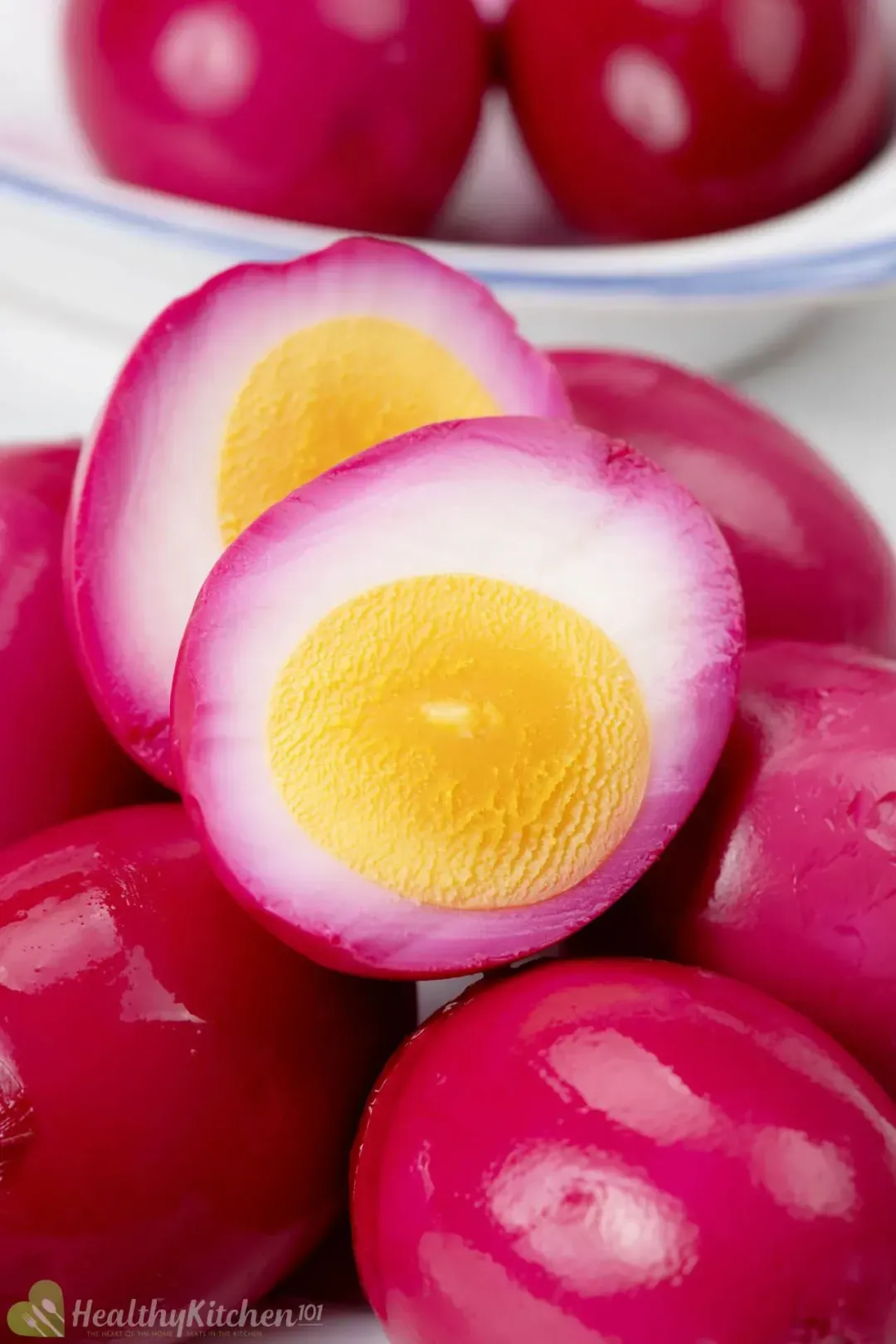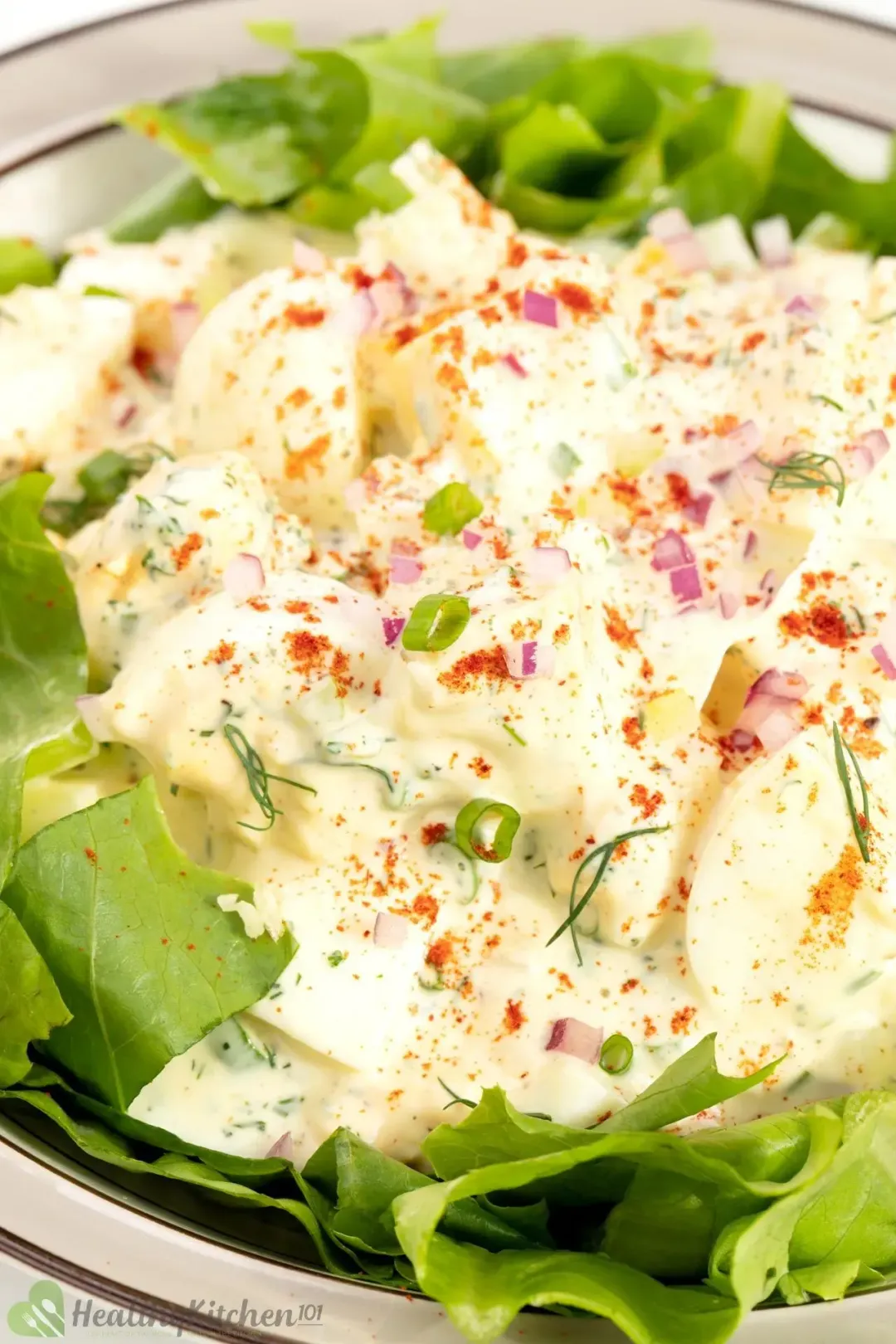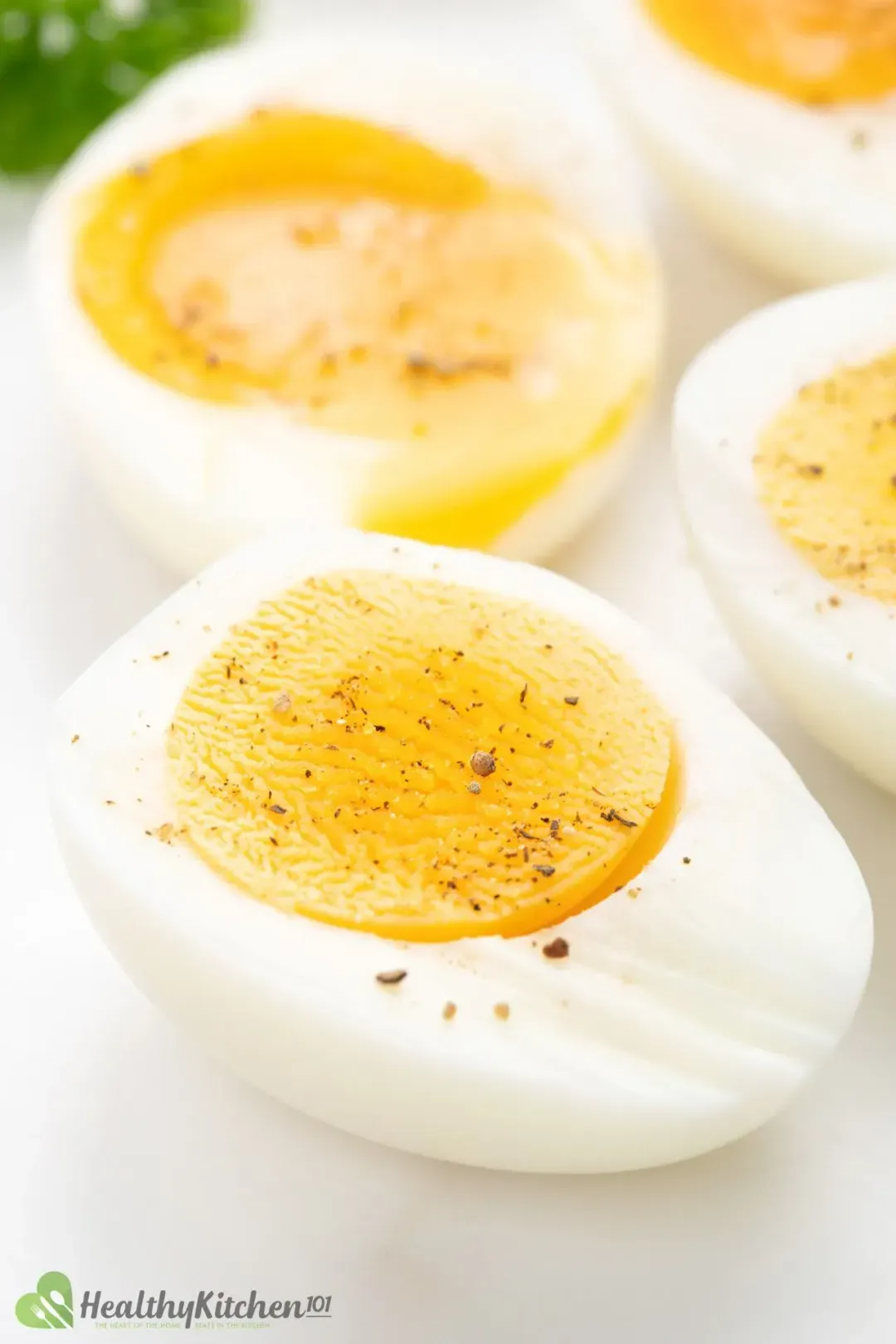Pickled eggs are both a delicious treat and fun to look at. They are reminiscent of giant pearls bobbing around in the sea.
A simple tweak turns them into a healthy dish with a uniquely vibrant color. The richness of the eggs and the bright acidity of vinegar gives them an interesting and appealing flavor.
These eye-catching eggs are perfect for salads, soups, or a quick protein-filled snack!
What Are Pickled Eggs?
Pickled eggs are typically hard-boiled eggs that are submerged in a vinegar-based brine. This brine can be sour, sweet, or spicy, depending on your personal preference.
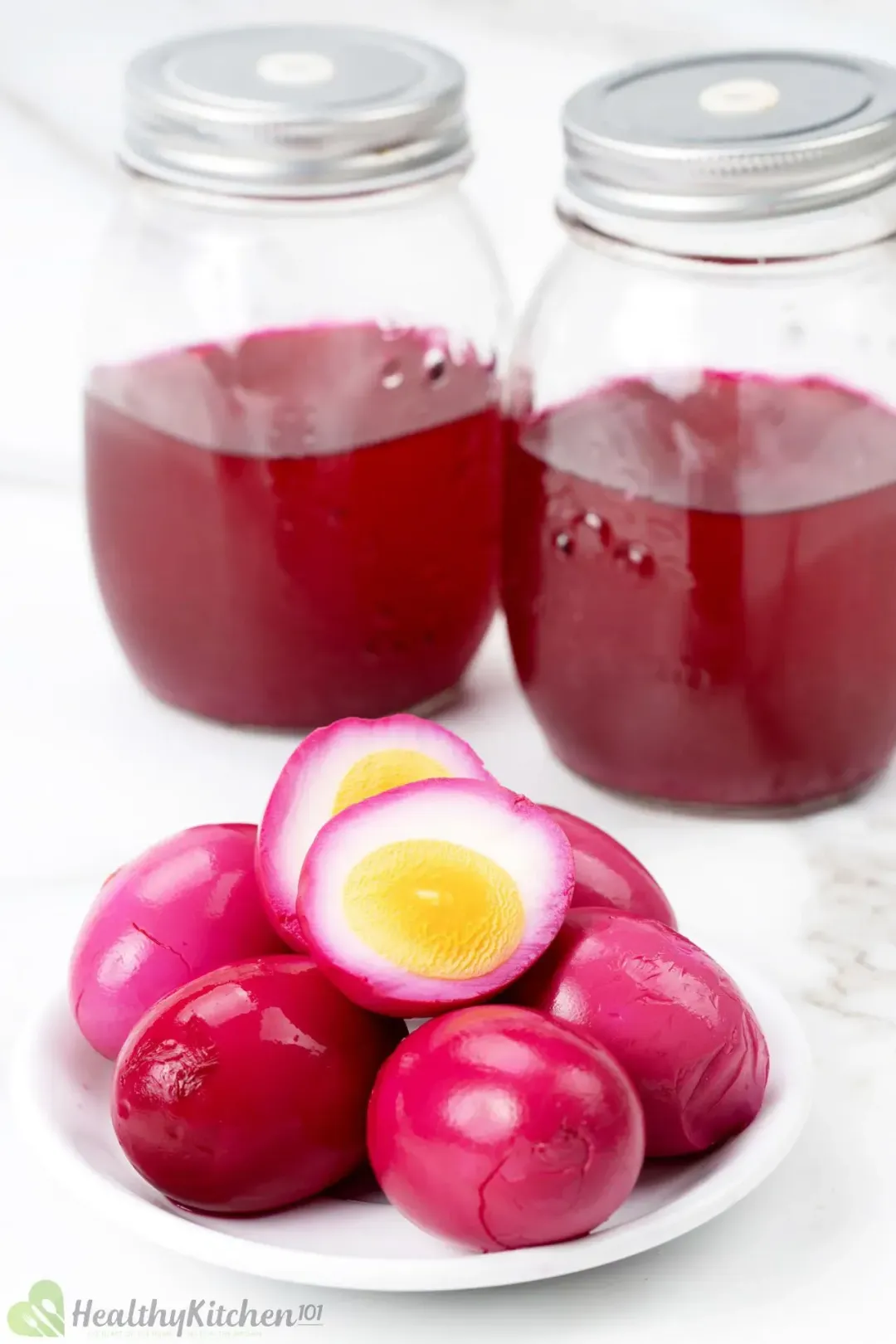
The eggs are in the brine from a couple of days to several months to allow them to absorb the flavor of the liquid. This technique can also be used in any kind of brined/pickled vegetable venture as long as the acidity level is appropriately low (at or below 4.6 pH).
Are These Pickled Eggs Good for You?
Pickled eggs are great to keep around your kitchen. But are they healthy?
With boiled eggs, beetroots, vinegar, and sugar as the ingredients, this pickled eggs recipe is pretty healthy. Each egg contains only about 72 calories, and is a good source of protein, providing 6 grams’ worth.
Cholesterol is the same amount found in an ordinary egg, about 164 mg, or 55% of your daily allowance. Studies suggest that healthy people can eat up to 3 eggs a day with positive outcomes, so one of these pickled eggs per day shouldn’t give you any health concerns.
Our other healthy recipes include these perfect sunny side up eggs, our simple method for cooking fluffy eggs, and these breakfast egg muffins.
Homemade Pickled Eggs and Beets
The name of the recipe reveals its main ingredients: eggs and beets. In this variation, both eggs and beets are pickled, which means we need an extra step— slice boiled beets for the brine.
Of course, you can use canned beets and keep their liquid for the brine mixture. However, we love the fresh note from raw beets, so spending a little time to prep beets is worthy.
With some sliced beets in your pickling jar, the eggs get the deep pink color, and the beets also absorb the tang from the brine. These classic pickled eggs are great with beer, or acts as a base for deviled eggs.
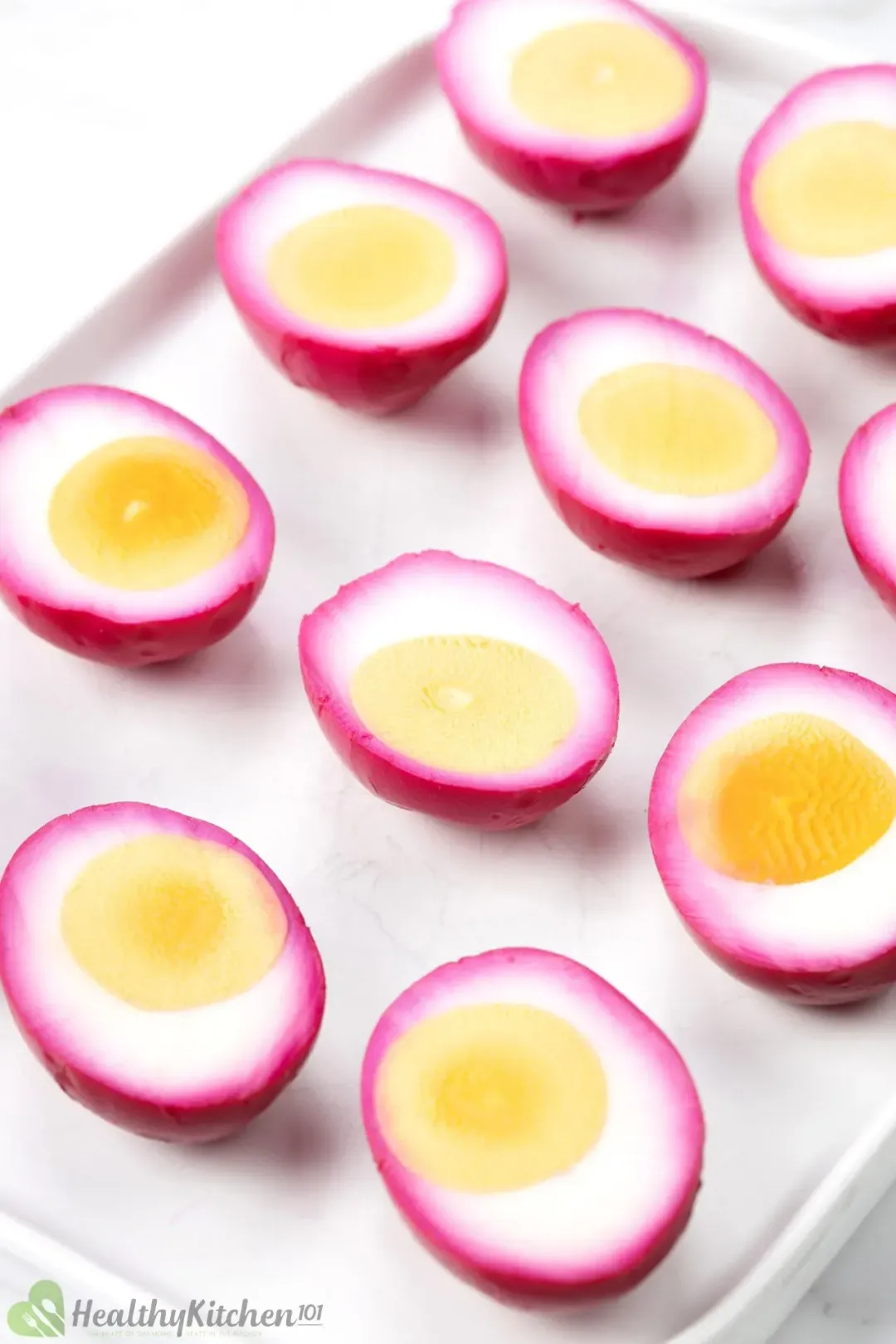
What Else Goes With Pickled Eggs
The awesome thing about pickled eggs is not only their superior taste, but also their versatility; it’s fun to play with their flavor and color.
If you so desire, there are many other ways to create pickled eggs that completely suit you. Eggs are easily adaptable to a huge flavor profile, such as cumin, turmeric, chili, or even kimchi, so this recipe is easily customizable.
When making pickled eggs, you can play with the seasoning to achieve the desired color. Our tip is to use a red beetroot for purple eggs, turmeric for yellow, and radish for pastel pink. Just remember that whatever you add will alter the flavor.
Can You Put Hard Boiled Eggs in Pickle Juice?
Yes, you can.
If it’s tepid juice, however, you will have to let the eggs sit for longer than 4 hours for the juice to be absorbed fully into the egg whites. You can also reuse the pickle juice for up to a week once the previous batch is finished.
Note that using the same pickle juice for more than 2 weeks might be risky, as there is less vinegar in the used brine to protect it from germ infection. The second-hand liquid also degenerates faster due to previous exposure to the air.
How Long Does It Last?
Vinegar in the pickle juice can act as a natural preservative to keep the eggs for about 7–10 days in cool weather. Refrigerating the eggs can help prolong their lifespan by up to 3 weeks.
It’s not advised to make a big jar of these and keep them for more than 20 days though. These eggs are so easy and quick to make that the time saved wouldn’t be worth the risk if they become spoiled.
We also have a large collection of healthy eggs recipes for your reference. Come check them out.
What to Serve with
Pickled eggs can be substituted in any recipe that calls for a hard boiled egg.
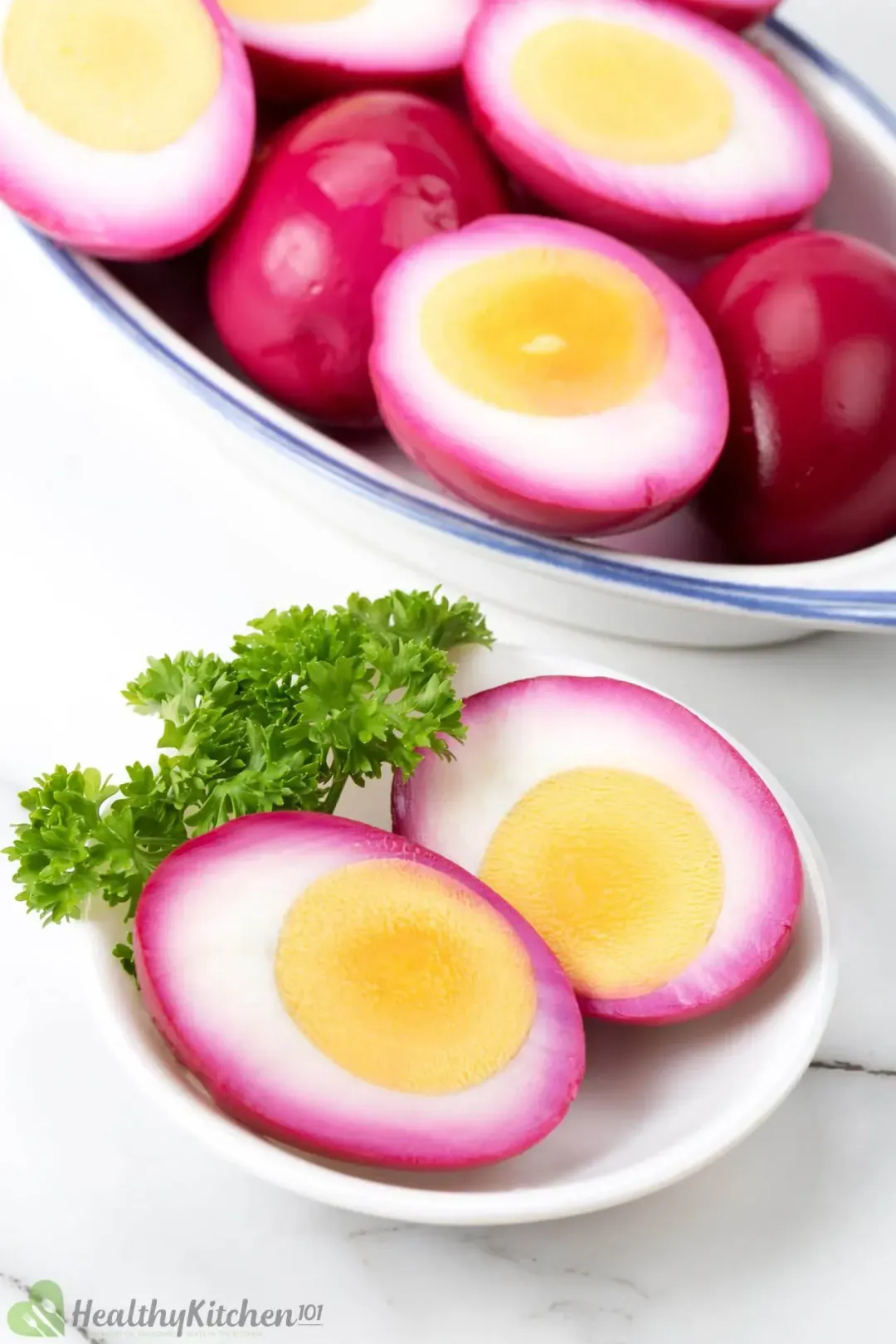
1. Salad
You can use pickled eggs in place of boiled ones in any egg salad recipe. The tangy pickles make the salad so tasty that you may find yourself wanting to have it as a light dinner or lunch every day.
2. Sandwich
Turn your regular egg sandwich into something more exciting by adding pickled eggs and beets. Pickles give an earthy flavor that pairs well with lettuce and tomatoes. Vegetarian sandwiches can be both eye-catching and delicious!
You can even try them in our recipe for deviled eggs or this recipe for scotch eggs and expect gorgeous results.
That’s enough of me talking, it’s time to get on with making this delicious treat!
More Egg Recipes to Try:
Pickled Eggs Recipe
This pickled eggs recipe gives pickled eggs a touch of spice along with a good, strong punch of tartness from vinegar, and an interesting pink color from beetroot. Appealing both visually and tastewise!
- cook TIME 15 mins
- prep TIME 15 mins
- total TIME 12 hr 30 mins
- INACTIVE TIME 12 hr
- COURSE Side Dish
- CUISINE British
- SERVINGS servings
- CALORIES 72 kcal
INGREDIENTS
- 8 eggs (*)
- 8 oz fresh beetroot
- 1 1/2 cups water
- 1/2 cup sugar
- 1/2 cup white vinegar
- 1/8 tsp salt
INSTRUCTIONS
Put 8 eggs in a pot and cover with cold water. Bring to a boil. Turn off the cooker and let the eggs stand in the hot water for about 8 minutes for firm but creamy yolks (check out How to Boil Eggs.)
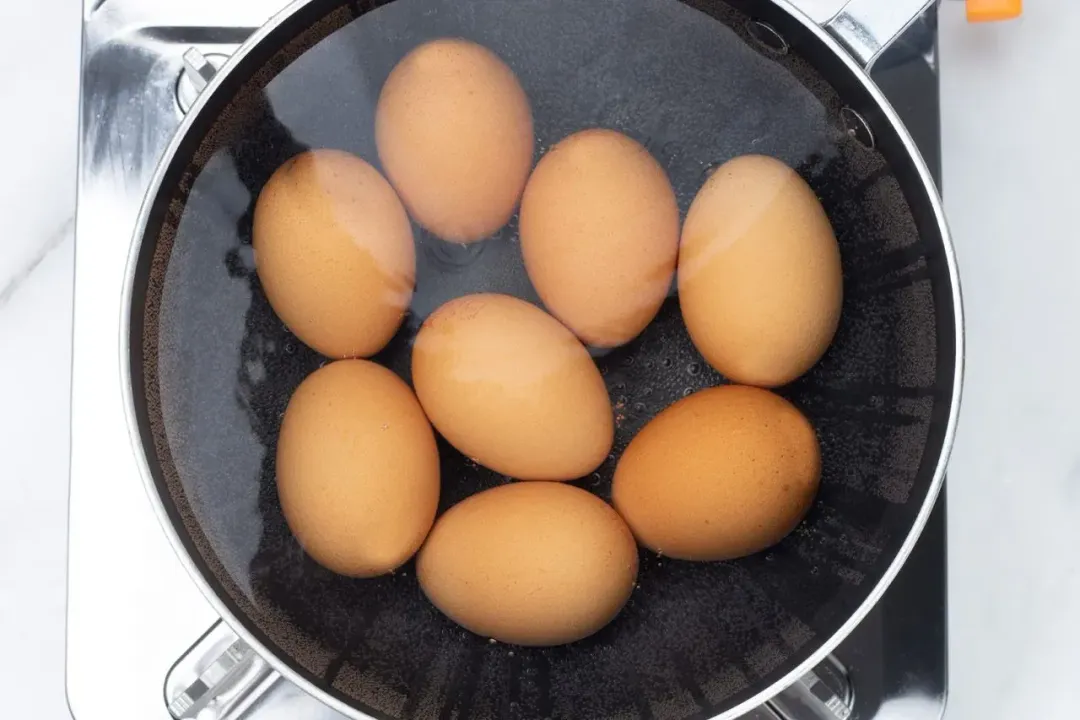
Process 8 oz beetroot through a juicer.
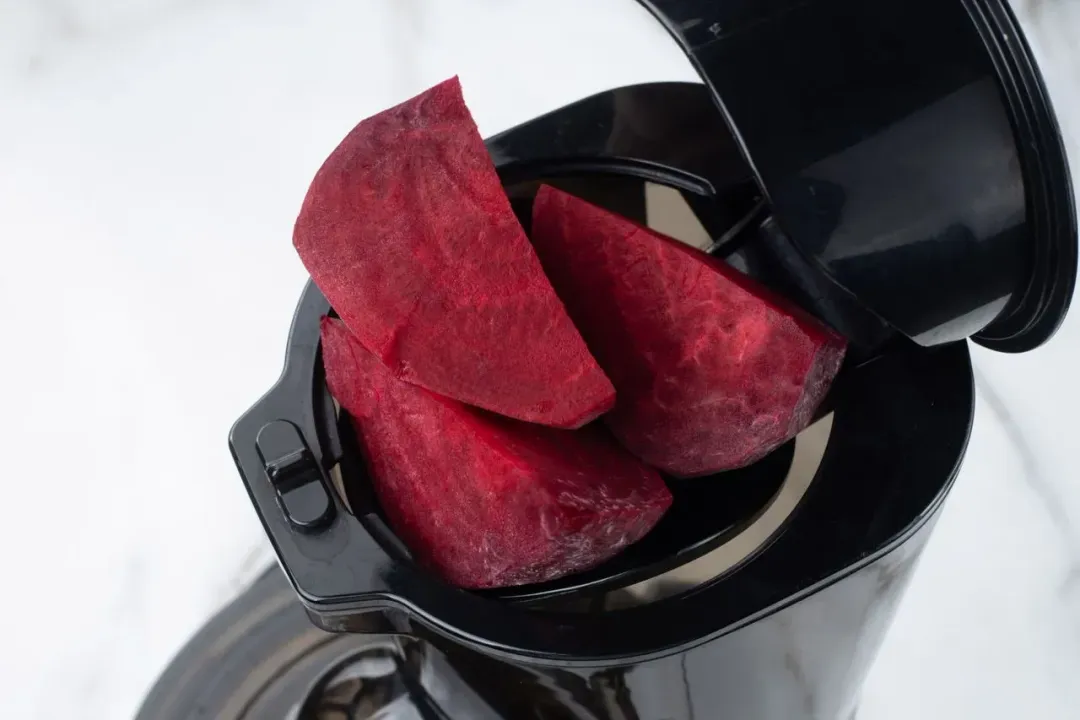
In a small saucepan, bring 1 1/2 cups water, beetroot juice, 1/2 cup sugar, 1/8 tsp salt, and 1/2 cup white vinegar to a boil. Remove the pan from heat.
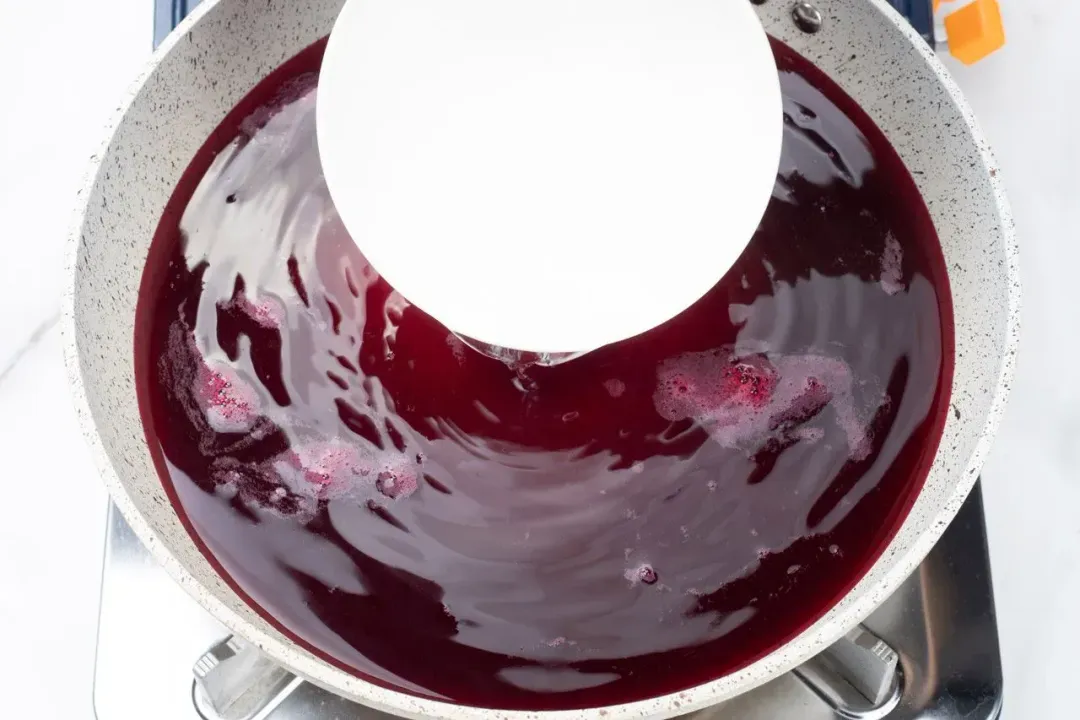
Peel the whole eggs.
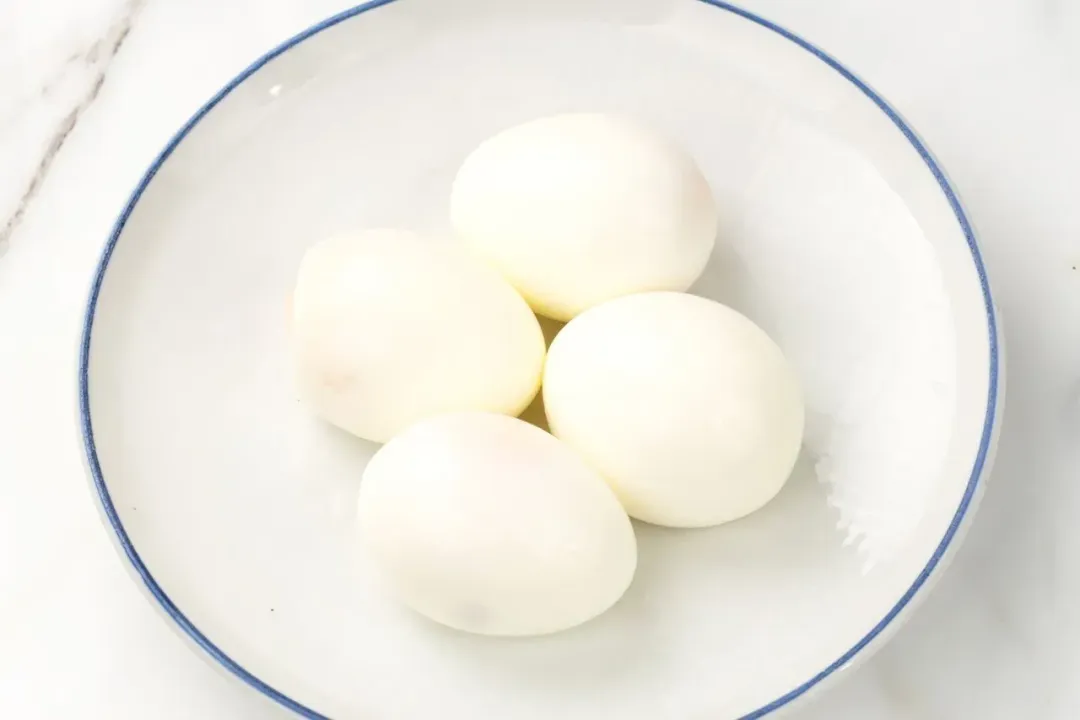
Put the eggs into a glass jar. Pour the brine mixture over to submerge. For best results, cover and chill for at least 12 hours before serving.
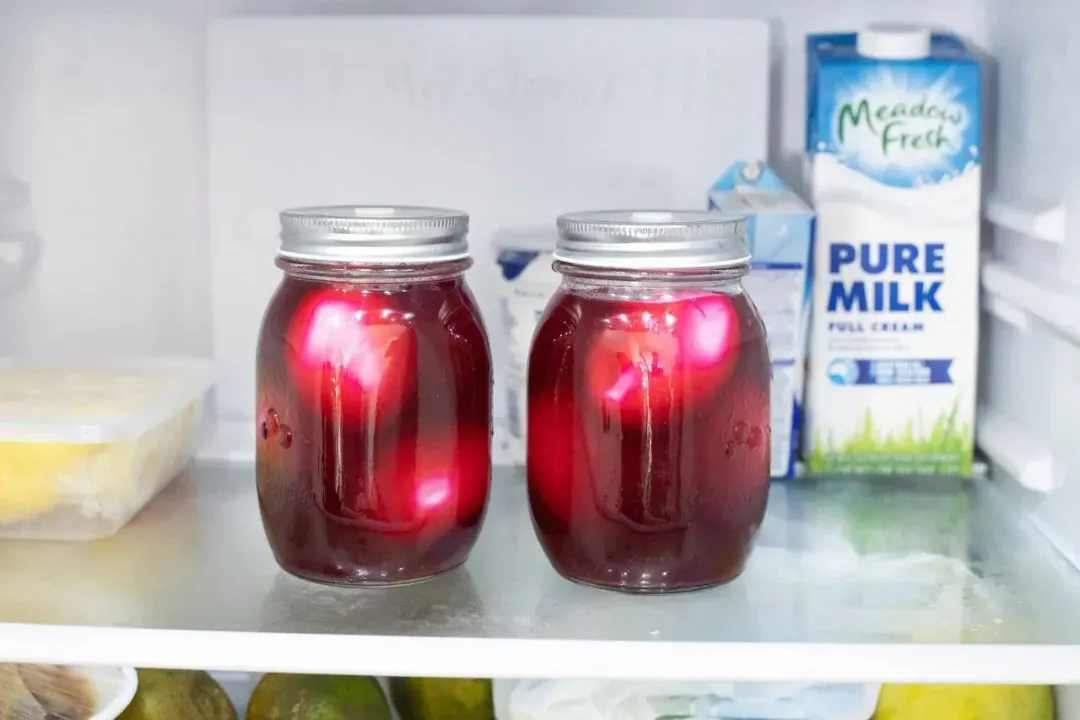
Because eggs don't absorb all nutrition from the brine, we've calculated nutritional values based on the eggs only.
NUTRITION
Tuyet Pham
Head Chef, Culinary ConsultantLuna Regina
Writer, AuthorLizzie Streit, MS, RDN, LD
Nutrition Reviewer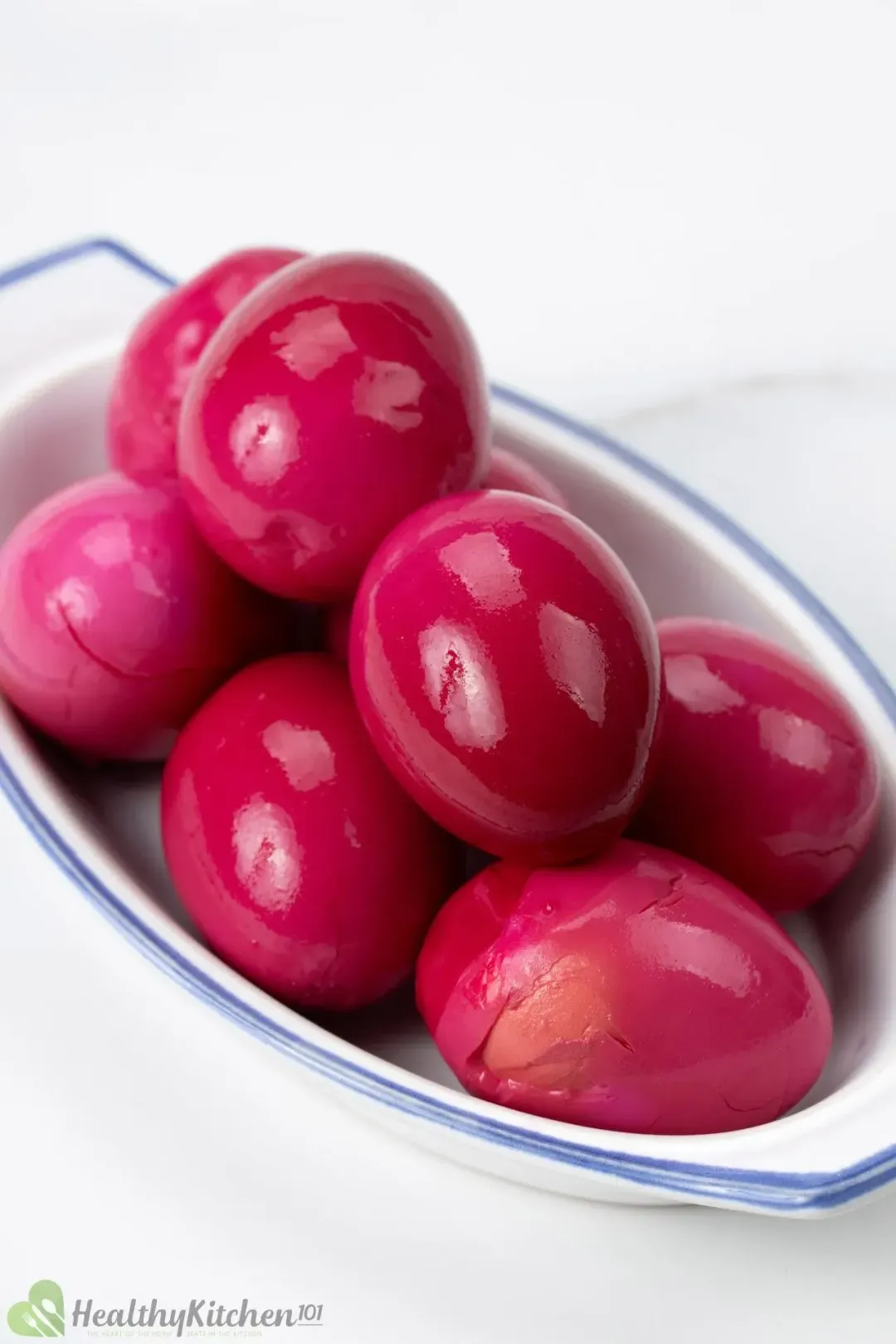
- Valentina
Wow, these eggs are absolutely stunning. I’ve made beet pickled eggs, but not for a while. Now I’m in the mood. You’ve achieved such a deep color. I love it.
- Natalie Ellis
I was surprised at this color also, that was somehow a success to me.
Hope you are going to have a good one soon!
- Cindy
Maaan! Everyone of y’all that has a recipe up here for pickled eggs make this process so complicated.
Just buy a bunch of jars or cans of pickled beets. Collect the pickled beet brine/juice from the can/jars in Mason jars Boyle your eggs, peel them and let them sit in the pickled beet brine/juice for arnd 3 days.
THAT is the easy way to make pickled eggs.without the fuss.
Happy Easter y’all ? - Joel
Also, when reusing the beet juice from one batch to the next, the pigment from the beet juice gets absorbed by the eggs, and so each batch of will be successively lighter.
- elaine eliopoulos
Eggs went fast! Can I put another batch in the same brine ( beet type)
- Luna Regina
Thanks for the question. You can absolutely reuse that brine as long as it doesn’t look cloudy or taste too sour. However, we don’t recommend using the brine more than that. Happy cooking!
- Mary Jane
Delicious! I used to hate the taste of beets when I was little, love them now…these are so yummy, I will be trying in my salad & lots of diff variations. Thank you for the recipe!!
- Luna Regina
Thanks, Mary!
- Louise BernelleI love these eggs, I also add sliced onion
